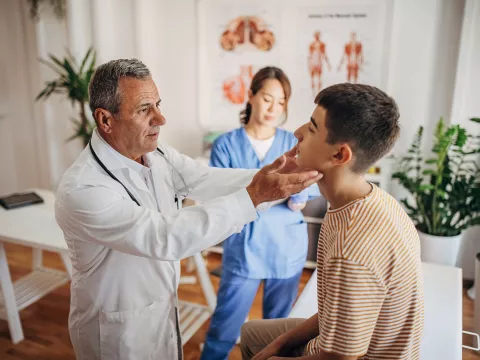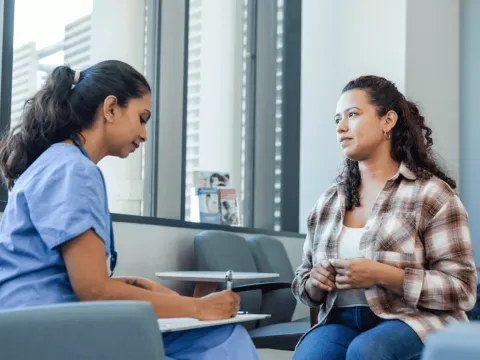- UChicago Medicine AdventHealth

Choose the health content that’s right for you, and get it delivered right in your inbox.
A back-to-school physical is more than just a routine doctor appointment. It’s a great way to get your child’s school year off to the healthiest start possible.
Back-to-school physicals (also called well-child exams) are a chance for the doctor to evaluate your child’s growth and development, screen for common childhood conditions and make sure immunizations are up to date. Here’s what you need to know to make the most of your child’s next check-up.
Schedule Early
Be sure to call your doctor’s office for an appointment before summer vacation ends or school starts, if you can. UChicago Medicine AdventHealth family medicine doctors provide thousands of back-to-school physicals every summer, and slots fill up quickly. Plus, there’s always a chance the doctor will want to order a follow-up test. If your child’s check-up happens late in the summer, you might not have time to schedule the tests before school starts.
Prepare Some Questions
Before the visit, think about any questions you have related to your child’s health. Maybe you’re worried about your child’s sleep habits, screen time or fitness level. Or maybe you’re wondering about keeping an extra inhaler in the nurse’s office or finding out if your child is still allergic to peanuts. If so, be sure to write your questions down. Back-to-school physicals can be busy, and it’s easy to forget what you wanted to ask.
When you arrive for your child’s appointment, let a nurse or physician assistant know about your questions so they can give the doctor a heads up.
Bring Your Forms
Many schools ask parents to fill out and return health-related forms before school starts in the fall, most of which require a doctor’s signature. These forms may:
- Allow the staff to give your child medication during the school day
- Clear your child to play sports
- Confirm that your child’s vaccinations are up to date
Be sure to bring those school health forms with you to your child’s physical. If you don’t have the forms you need, check the school website or call the school secretary for help.
Think About Other Prescriptions
It’s also important to bring along a list of the medications your child takes regularly. If any of your child’s medications were prescribed by another doctor, such as a specialist, your child’s doctor might not be aware of them. Just jot down the drug name, dosage and how often your child takes the medication, and bring that information with you. Another option would be to download the UChicago Medicine AdventHealth App, where you can find physicians, schedule appointments, create personalized medical profiles for your whole family, and more.
Be sure to let the doctor know if your child received other medical care in the last year. This could include physical therapy, speech therapy or chiropractic care, for example.
Prepare for Immunizations
Immunizations keep kids and communities safe. They protect infants, children and teens from serious diseases. All school systems require certain immunizations in order for children to attend classes. Your child’s back-to-school physical is the ideal time to get up to date on those shots. If your child missed any immunizations at a younger age, the doctor may give “catch-up” immunizations.
Consider mentioning any upcoming immunizations to your child — some kids like to know in advance.
Understand Common Screening Tests
Health screenings are a vital part of any back-to-school physical. Depending on your child’s age and health history, these tests may include:
- A screening for spine problems
- A urine test, to detect signs of infection or Type 1 diabetes
- A vision check
- Blood work to look for signs of high cholesterol or low iron count
- Heart and blood pressure tests
- Tests to check developmental milestones
If any of these screenings suggest a possible problem, the doctor will talk to you about it. The doctor may order follow-up tests to learn more.
Talk It Out
During the appointment, the doctor will want to talk with you and your child about health and safety. The conversation might cover topics such as exercise, nutrition, healthy sleep patterns, school work or household chores. It’s a way for the doctor to learn more about your child’s whole health and identify problems that may need medical care.
You’re welcome to talk with the doctor privately about your child’s health as well. Remember, the doctor is here to provide care, support and resources. No question is “out of bounds.” Chances are, your child’s doctor is very familiar with whatever concerns you have and can help.
Request Prescription Refills
If your child needs the school office or school nurse to keep extra medication on hand, let your doctor know. These can include:
- An emergency inhaler for asthma symptoms
- An EpiPen for severe allergic reactions
- Insulin for Type 1 diabetes
- Medication for attention deficit disorder
Before You Go
At the end of the appointment, you’ll leave the doctor’s office with an after-visit summary and completed forms – your child may even receive a sticker for a job well done. More importantly, you’ll have the peace of mind knowing you’re doing all you can to start your child’s next school year in the healthiest way possible.
If you need a family medicine doctor, UChicago Medicine AdventHealth is here to help. Find a doctor who will be your child’s partner in whole health today.


